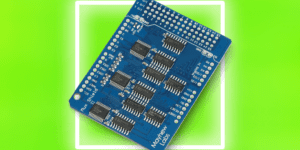If you’ve spent some time (at least) in communities seriously focused on electronics, programming, 3D printing, or just broadly defined DIY with modern style and technology, you’ve probably heard of Arduino and Raspberry Pi platforms.
What is this thing, and why it is so popular? Raspberry Pi is a small computer on a single circuit board. For some projects, however, it may be overkill, and something like a simpler but even more basic computer that can perform the same tasks over and over again and be used to complete a project is more useful. That’s the place where Arduino microcontroller and programming platform come on stage.
There are many boards and even more applications. Botland and Arduino communities of do-it-yourselfers, electronics, robotics and programming enthusiasts can help you choose the right one. Such groups are constantly taking advantage of new opportunities and exploring every new application of Arduino in every possible project. It’s not some niche, electronics-laden chip that only a select few can handle. You can even create DIY games on Arduino.
Arduino and Raspberry Pi – introduction
“Complicated differently” than single board computers (SBC) like the Raspberry Pi, microcontrollers are an inexpensive way to realize a variety of useful DIY devices. We can actually build a lot of projects on top of Arduino. It is something like providing a backbone instead of a brain. The differences are significant. Arduino, on the other hand, is one of the leading brands of microcontrollers and development platforms, and we would even venture to say the world’s #1. It leads the way in using various technologies, you can find simple examples of it everywhere on the web.
It is worth remembering that the platform is compatible with optional components called shields, which specialize in specific tasks. This can be, for example, operating a CNC machine, navigating appropriate programs or specialized sensors, an example of which is the thermometer we all know. The possibilities are endless. You can also find some suggestions, tips and general information in Arduino Botland Blog category, the very same where this article is located.
What can you do with an Arduino?
The article will feature external paths to interesting places from where we can bring out the best in Arduino – finished projects and tips on how to create something of your own. Don’t forget about Arduino Project Hub.
1. Robotics
Arduino boards, modules, and off-the-shelf solutions are perfect for beginner to intermediate robot development projects. They are powerful enough to execute the basic commands a robot needs to operate, while focusing its limited resources on the tasks at hand. This eliminates interference and resource drain from other programs running in the background.
You don’t need hugely complicated, and certainly expensive, parts to create a robot. Plenty of kits and modules for this can be found at Botland. The topic is so popular that we have even dedicated a separate category to it, which has been given the graceful name Build a Robot!
Where to go, where to look?
Where to go, where to look?The aforementioned category is based not only on Arduino, but if that’s what you’re going for, it’s worth taking a look at something on Arduino Tutorials – this is the place on the web many return to time after time for Arduino-based capabilities.
2. Audio

From Hi-Fi to headphones, one of the factors driving innovation is sound quality. It needs to be said bluntly – Arduino doesn’t have the processing power to produce really good sound, but it can add an audio element to new projects. This allows you to experiment and practice so that you can realize really clear sound in the future.
Where to go, where to look?
Electronics Lab – interesting library of projects here.
3. Internet of Things (IoT)


One of the most exciting trends of the past decade is the rise of the Internet of Things, or physical objects that can receive instructions via the Internet. From controlling the watering of a field hundreds of meters away, to the programmer of a coffee maker or refrigerator, or even an entire house, these objects allow for a more connected future. They are often combined with the smart home trend – home automation and the solutions offered by a smart building are something worth trusting, and not just for the sake of sweet laziness. Besides, why limit yourself only to the house? We can also improve the garden, as presented by a project like Garduino for the garden, or better prepare for the weather with a weather station.
Where to go, where to look?
Instructables is just another place with great tutorials. Drop-down menu found there contains other sections also.
4. Tools & workshop
Whether we’re hobbyists or professionals with a print farm, machines like 3D printers, CNC machines, laser cutters, and similar machines have really expensive parts and add-on accessories even for basic models. Fortunately, there are workarounds, including DIY maker builds where we supply the motors ourselves and program everything with an Arduino to help us out.
https://www.youtube.com/watch?v=WU1NYvxZfU4https://www.youtube.com/watch?v=hK6eKUrNItc
Where to go, where to look?
Actually all of the places mentioned in the article, because tools can be plentiful and very different.
5. Recording and managing data
What sort of platform would it be if it didn’t serve data? And we have more and more of them around us. They have an annoying habit of flooding us from head to toe, so it makes sense to organize them and even automate something if possible – and there are truuuuly many ways to do it. Arduino can compile an inexpensive and portable data tracking kit, whether you need it to study how many animals are running around in the forest or how many bites it takes to devour a bar of chocolate. With off-the-shelf designs, the whole philosophy is to type in the code, run the module, and you’re ready to enjoy the conveniences that precise notifications can offer.
https://www.youtube.com/watch?v=xBul0O-3Lp0https://www.youtube.com/watch?v=MUJ7ceqfNTs
Where to go, where to look?
r/Arduino subreddit reigns supreme on the theory that Reddit is the true content heart of the Internet. Well, mostly.
6. Networking tasks and communication with other devices

Nowadays, a computer that can’t connect to others is an almost useless machine. Most Arduino devices have built-in networking capabilities – usually in the form of an Ethernet port. This allows for more diverse applications, including the aforementioned IoT and data-logging projects. Communication modules in the form of shields allow us to connect to various external processes via Bluetooth or WiFi. We can also try GPRS projects or creating a system based on recently popular LoRa protocol.
Where to go, where to look?
Random Nerd Tutorials has an extensive collection of Arduino tutorials, including a section on connectivity.
7. Fashion

Yes, that too! Arduino stands as the base for many bearable fruits of wearable technology. And so, for example, the LilyPad Open Platform is a compatible board that can be sewn to clothing or fabric and base everything on light, sound, vibration, and even body input such as a button press. All thanks to sensors. This is also where you can often find Arduino-compatible boards that have been made thanks to the benefits of open-source.
Where to go, where to look?
Project IoT includes great tutorials, including a Lilypad tutorial that will teach the components, purpose, and programming of this board that is trending among makers.
8. It’s a good idea to start somewhere
Such an amount of possibilities can overwhelm. We look at all those connectors sparkling in the light of workshop lamps, the characteristic greens and blues of PCBs, the connections, joints and attachments laboriously created by electronics engineers. The first thing that comes to our minds is that this is probably not for us. All looks cruelly complicated, and some of the installations resemble a TV set after an encounter with a sidewalk slab or a disassembled radio that we’ve seen when we were young… once, or maybe twice.
However, everything can be disenchanted. To be completely honest – it should be. Countless inventions are considered very specialized and require a long study of theory, not less practice and often an angelic patience. The ideal way to organize not only the hardware, but also the gradually expanded knowledge – because it will come with time, believe us, there is no greater joy than the moment when it all starts to come together – are Arduino courses and starter kits. They will provide everything you need. And then you can decide on your own if you like it for sure, or if it’s not for us. Who knows, maybe tomorrow you will find that this is exactly what you want to do for the rest of your life?

How useful was this post?
Click on a star to rate it!
Average rating 0 / 5. Vote count: 0
No votes so far! Be the first to rate this post.



